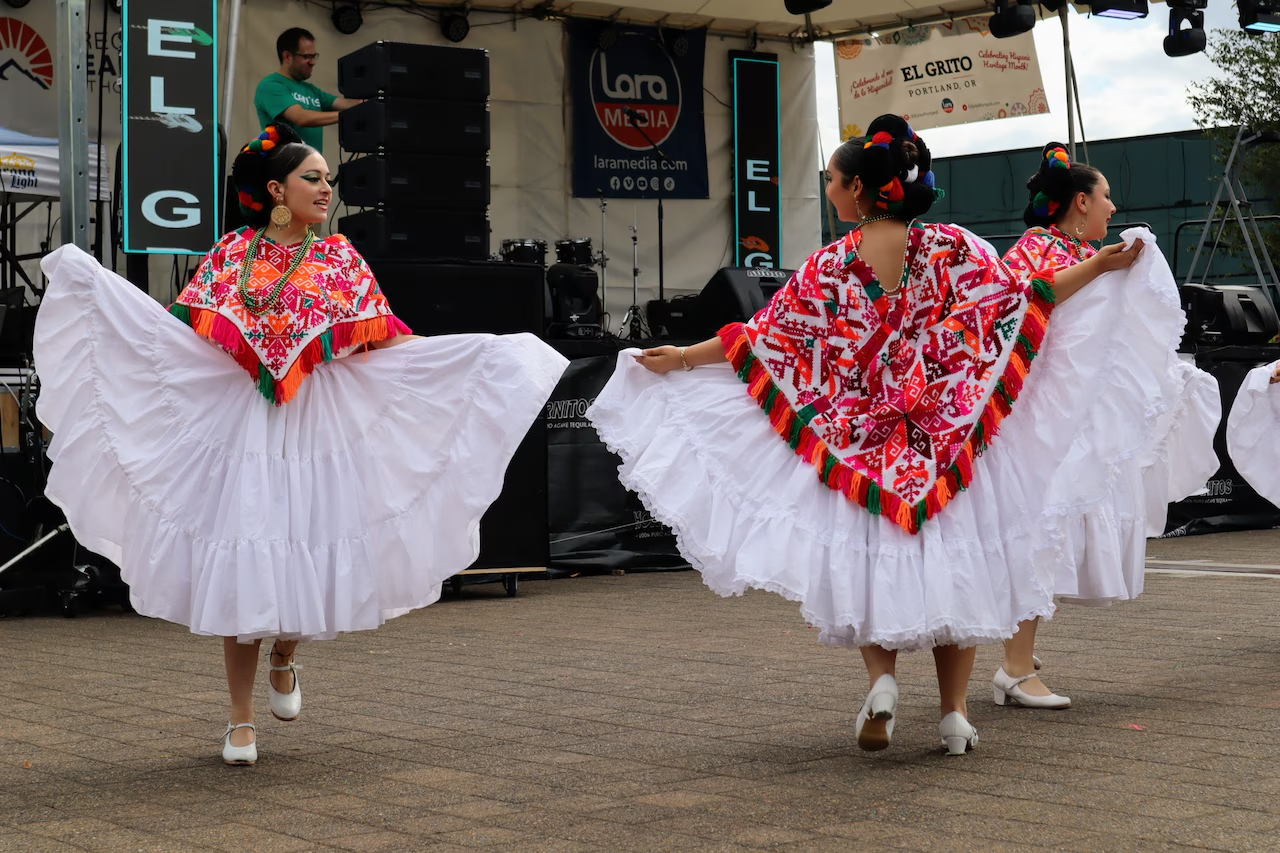PORTLAND, Ore. – The blast of trumpets, the rhythmic beats of traditional drums, and the high-pitched shouts of gritos filled the Rose Quarter Commons on Sunday as El Grito Portland returned for its 19th year. Billed as the largest fully Latinx-owned and organized Hispanic Heritage Month event in the Northwest, the celebration drew together hundreds of performers, vendors, and community members for two days of culture, history, and joyful resistance.
A Festival of Unity
El Grito Portland marks the beginning of Hispanic Heritage Month, observed nationally from Sept. 15 to Oct. 15. Beyond the food, music, and dancing, organizers say the event is about unity.
“It captures our essence as Latinos,” said Victoria Lara, CEO and founder of Lara Media Services, which has produced the festival for nearly two decades. “This is a labor of love and giving and sharing. We are not divided. We are all together.”
Also Read
The two-day festival opened with a performance by the dance group Huehca Omeyocan, honoring Mexico’s pre-Hispanic traditions. Vendor booths featuring Latino artisans lined the Commons, selling everything from embroidered textiles to handmade jewelry. Nearby, families lined up for tortillas hot off the griddle, tacos, and aguas frescas.
A Celebration Amid Challenges
This year’s El Grito arrives at a delicate moment. Some Hispanic Heritage Month celebrations in Oregon have been scaled back or canceled. Centro Cultural in Hillsboro moved its celebration online, citing fears about immigration enforcement. Latino Fest in central Oregon was canceled, and ¡Viva Salem! ended due to budget constraints.
Lara acknowledged the fears but insisted that Portland’s celebration go forward. “Yes, we are scared,” she said. “I wasn’t documented for more than 20 years. I know there are a lot of people scared. I cannot cancel, because I know our community also needs hope. And I always say my dreams are bigger than my fears.”
Honoring the Struggle for Independence
At the heart of El Grito is a remembrance of El Grito de Dolores, the historic call to arms that began Mexico’s war for independence in 1810. On Monday night, the festival will stage a reenactment of the cry at 8 p.m., complete with flags, bells, and music.
For attendees like Rosa Lemus, the symbolism is powerful. “With all the history in our country, it’s very important that people have that freedom,” she said, reflecting on Mexico’s independence. “We have the freedom to be here. I know these are really hard times for a lot of us, but I just feel that we have to be here for the ones that cannot be here.”
Her child, Isabel Lemus Kristensen, echoed that message. “If you’re celebrating your culture, that’s resisting,” Isabel said. “Regardless of what’s going on, it feels good to just be with people who get your culture, your background, your language. It feels good to have that celebrated.”
A Place to Belong
For many, the festival provides more than food and entertainment—it offers belonging. Estrella Zamora, a University of Portland student, said the event reminded her of home. “I’m away at college right now, so it’s bringing back a little piece of home. Being where my culture is, that’s where home is.”
Her friend Jackie Espina agreed, saying El Grito helps her reconnect with her Guatemalan roots. “It feels like being back in Guatemala. Seeing people like me, seeing our food, seeing everything, it’s so fun.”
Vendors Weaving Past and Present
Dozens of vendors used El Grito as an opportunity to showcase their heritage. Carmen Rodriguez and Daniela Lopez, originally from Oaxaca, filled their booth with embroidered bags, pillowcases, and decorative textiles. Sales help fund free soccer camps for underserved youth across Washington state.
“My mom and my grandma used to make all these things,” Rodriguez said. “The idea is to connect our roots, but at the same time, help our community here.”
Another booth, Cositas PDX, offered handmade clay earrings crafted by owner Lesly Ramos. For Ramos, creating and sharing her art is both a livelihood and a cultural statement.
Inspiring the Next Generation
El Grito also prioritizes education. Monday’s program includes the Futures for Latinx Youth initiative, inviting high school students to network with Latino professionals, entrepreneurs, and public officials. Younger children can explore hands-on learning centers that teach cultural traditions, from cooking to crafts.
“Last year we had around 200 students,” Lara said. “This year, 750 registered. That tells you the need for connection, the need to hear something that lifts their experience.”
The sharp increase, she noted, reflects a growing hunger for cultural affirmation and opportunities among Latino youth in Oregon.
Joyful Resistance as a Theme
Despite fears over immigration enforcement and rising anti-immigrant sentiment nationwide, the festival embraced the theme of joyful resistance.
“This celebration isn’t ignoring what our community is living,” Lara said in Spanish. “This celebration is sending a message of hope, that we are here and we understand. … I don’t want fear to disable me from facing challenges. I will not let anything take away from the beauty of life, because life is more beautiful than fear.”
Looking Ahead
El Grito Portland continues Monday from 11 a.m. to 10 p.m., with more music, traditional dances like Flor de Piña from Oaxaca, and a vendor market featuring Latino-owned businesses.
For Lara, the festival is both a cultural celebration and a statement of resilience. “This is about telling our community, ‘You are seen, you are valued, and your traditions matter.’”
As the trumpets blared and voices rose in unison on Sunday night, El Grito Portland once again reminded attendees that to celebrate culture is to resist, and to resist with joy is to build community.












